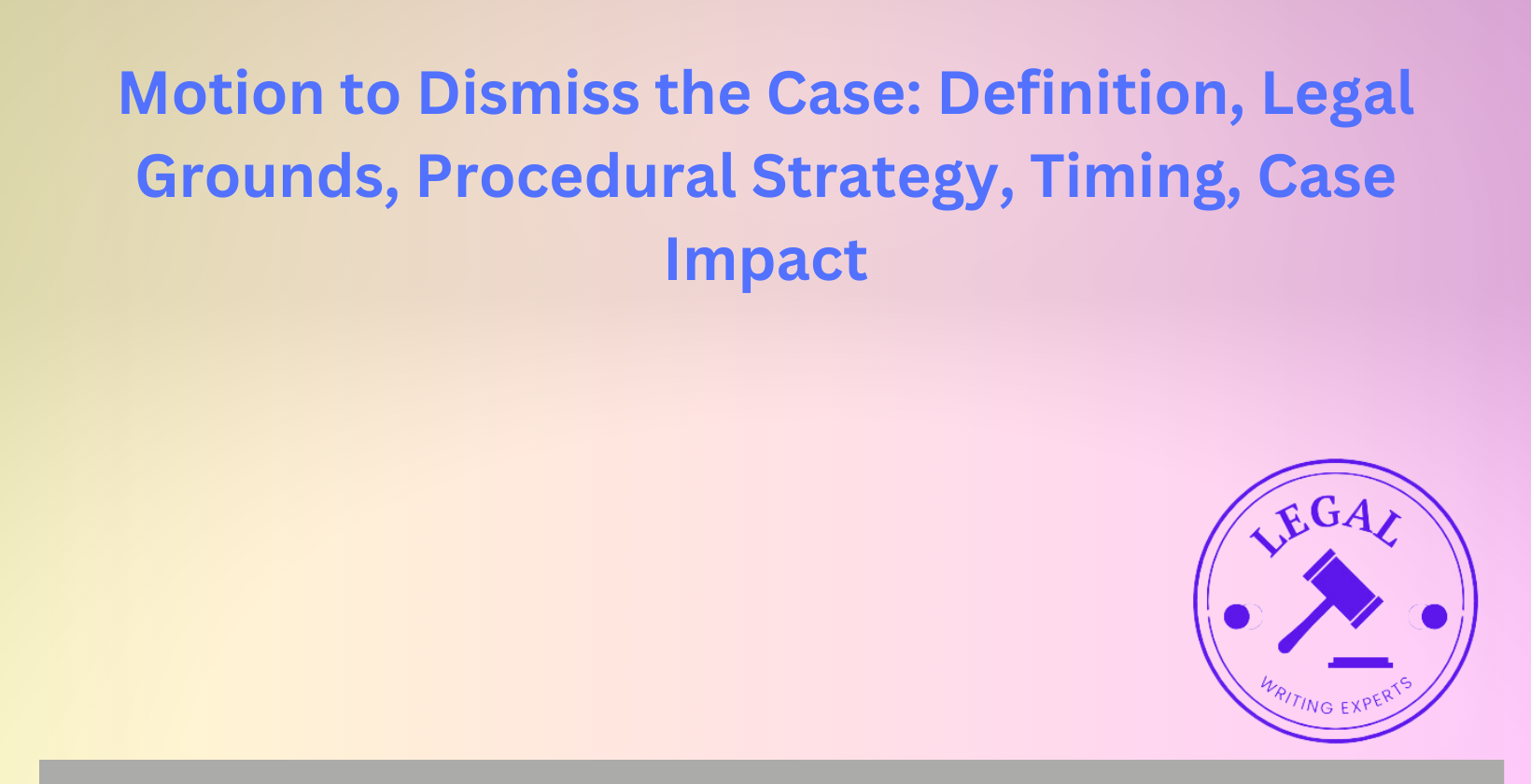Motion to Dismiss the Case
Written by
Jessica E
September 30, 2024 · 8 min read

A motion to dismiss is a formal request made to a court to terminate legal proceedings before they reach trial. This legal maneuver serves as a critical tool for defendants seeking to challenge the validity or sufficiency of a lawsuit at its early stages. Motions to dismiss can be filed based on various grounds, including lack of jurisdiction, failure to state a claim, or procedural defects. The timing, strategy, and impact of these motions play crucial roles in shaping the course of litigation. This article explores the key aspects of motions to dismiss, including their definition, legal grounds, procedural considerations, and potential outcomes.
What Is a Motion to Dismiss a Case?
A motion to dismiss a case is a formal request filed by a defendant asking the court to terminate legal proceedings against them. The motion argues that even if all the facts alleged by the plaintiff are true, there is no legal basis for the lawsuit to continue. Courts typically evaluate motions to dismiss based solely on the pleadings, without considering additional evidence. The primary purpose of this motion is to challenge the legal sufficiency of the complaint and potentially end the case before it progresses to more time-consuming and costly stages of litigation.
How to Write a Motion to Dismiss a Case?
Writing a motion to dismiss a case requires careful attention to legal standards and procedural rules. The motion should begin with a clear statement of the legal basis for dismissal, followed by a concise summary of relevant facts from the complaint. The body of the motion must present persuasive legal arguments, citing applicable statutes, case law, and court rules. Each argument should explain why the plaintiff’s claims fail to meet legal requirements or why the court lacks jurisdiction. The motion should conclude with a specific request for the court to dismiss the case, either in whole or in part. Proper formatting, adherence to local court rules, and clear, concise writing are essential for an effective motion to dismiss.
Where to Hire a Legal Writer to Draft a Motion to Dismiss?
Legal writers capable of drafting motions to dismiss can be hired through Legal Writing Experts channel. Legal Writing Experts has in-house legal writers or contracts with freelance legal professionals. Legal Writing Experts is an online platform that provides access to experienced legal writers. We specialize in connecting law firms and companies with qualified legal professionals for specific projects. We also offer referral services for legal writing specialists. When hiring a legal writer, consider their experience with motions to dismiss, knowledge of relevant laws, and familiarity with local court rules to ensure a high-quality, effective motion.
How to File a Motion to Dismiss?
Filing a motion to dismiss involves several steps. First, draft the motion according to local court rules, including any required formatting and content specifications. Next, prepare a notice of motion and any supporting documents, such as memoranda of law or exhibits. File the motion with the court clerk, either electronically or in person, depending on the court’s procedures. Pay any required filing fees. Serve copies of the motion and all supporting documents on the opposing party or their attorney, following proper service procedures. File a proof of service with the court to demonstrate that the other party has been notified. Check local rules for any specific deadlines or additional requirements for filing motions to dismiss in your jurisdiction.
What Are the Legal Grounds for Filing a Motion to Dismiss?
Legal grounds for filing a motion to dismiss vary depending on the nature of the case and applicable laws. Common grounds include lack of subject matter jurisdiction, where the court does not have authority to hear the case. Personal jurisdiction issues arise when the court lacks power over the defendant. Improper venue claims argue the case should be heard in a different court. Failure to state a claim upon which relief can be granted asserts that even if all allegations are true, they do not constitute a valid legal claim. Statute of limitations defenses argue the lawsuit was filed too late. Lack of standing challenges the plaintiff’s right to bring the lawsuit. Failure to join a necessary party may be grounds if an essential party is missing from the case. Each ground requires specific legal arguments and evidence to support the motion to dismiss.
What Is the Procedural Strategy for Filing a Motion to Dismiss?
The procedural strategy for filing a motion to dismiss involves careful timing and consideration of potential outcomes. Evaluate the strength of dismissal grounds early in the case to determine if filing is advantageous. Consider whether partial or complete dismissal is appropriate based on the claims presented. Assess the potential for amendment of the complaint and whether dismissal would likely be with or without prejudice. Strategize about the impact of the motion on discovery and other pretrial proceedings. Determine if alternative motions, such as for a more definite statement, might be more appropriate. Consider the judge’s tendencies and local practice norms when crafting arguments. Prepare for potential outcomes, including denial of the motion or leave to amend granted to the plaintiff. A well-executed procedural strategy can significantly influence the course of litigation and potential settlement negotiations.
What Timing Considerations Are Important When Filing a Motion to Dismiss?
Timing considerations are crucial when filing a motion to dismiss. Most jurisdictions require motions to dismiss to be filed before or concurrently with the answer to the complaint, typically within 21 to 30 days of service. Some grounds for dismissal, such as lack of subject matter jurisdiction, can be raised at any time during the proceedings. Consider the impact of filing on other deadlines, such as for discovery or pretrial conferences. Evaluate whether early filing might prompt the plaintiff to amend the complaint, potentially strengthening their case. Assess if delaying the motion might allow for gathering additional information to support dismissal arguments. Balance the desire for quick resolution against the need for thorough preparation. Be aware of any local rules or standing orders that may affect timing requirements for motions to dismiss.
What Is the Impact of a Motion to Dismiss on Ongoing Litigation?
The impact of a motion to dismiss on ongoing litigation can be significant. Filing the motion often stays discovery proceedings, potentially saving time and resources. The motion can narrow the issues in the case by eliminating certain claims or parties. A successful motion may terminate the litigation entirely or force the plaintiff to amend their complaint. Even if denied, the motion can provide valuable insights into the court’s view of the case and highlight weaknesses in the plaintiff’s arguments. The process of briefing and arguing the motion can clarify legal issues and factual disputes, potentially facilitating settlement discussions. A pending motion to dismiss may influence case management decisions and scheduling. The outcome of the motion can shape the strategic direction of the case for both parties moving forward.
What Happens If a Motion to Dismiss Is Denied?
When a motion to dismiss is denied, several outcomes are possible. The case typically proceeds to the next stage of litigation, often entering the discovery phase. The defendant must file an answer to the complaint within a specified time frame, usually 14 to 21 days after the denial. The court’s decision may provide guidance on legal issues that will shape the rest of the case. In some instances, the court may grant leave to amend the complaint, allowing the plaintiff to address deficiencies identified in the motion. The denial may be without prejudice, allowing the defendant to refile the motion later if new grounds arise. Defendants may consider appealing the denial if there are strong legal grounds and the ruling significantly impacts the case. Strategically, parties often reassess settlement possibilities following a denied motion to dismiss.
What Are Common Case Examples Involving Motions to Dismiss?
Common case examples involving motions to dismiss span various areas of law. In contract disputes, defendants may move to dismiss based on statute of frauds violations or failure to allege essential contract elements. Employment discrimination cases often face motions to dismiss for failure to exhaust administrative remedies or meet statutory filing deadlines. Personal injury lawsuits may be challenged on jurisdictional grounds or for failure to allege necessary elements of negligence. In securities fraud cases, defendants frequently move to dismiss for failure to plead fraud with particularity as required by law. Constitutional challenges to government actions may face motions to dismiss for lack of standing or political question doctrine. Intellectual property infringement cases might see motions based on statute of limitations or failure to state a claim for the specific type of infringement alleged. These examples illustrate the diverse contexts in which motions to dismiss play a critical role in litigation strategy.
How Does a Motion to Dismiss Differ Between Civil and Criminal Cases?
Motions to dismiss differ significantly between civil and criminal cases. In civil cases, motions to dismiss typically challenge the legal sufficiency of the complaint or the court’s jurisdiction. They are often based on procedural defects or failure to state a claim upon which relief can be granted. Civil motions to dismiss are usually filed early in the proceedings and decided based on the pleadings alone. In criminal cases, motions to dismiss may challenge the sufficiency of the indictment or information, argue that the statute of limitations has expired, or assert violations of constitutional rights, such as speedy trial or double jeopardy. Criminal motions to dismiss can be filed at various stages of the proceedings and may involve evidentiary hearings. The standard for granting dismissal is generally higher in criminal cases due to the presumption of innocence and the state’s burden of proof. Civil dismissals may be with or without prejudice, while criminal dismissals with prejudice are less common due to public safety concerns.
What Are the Differences Between Voluntary and Involuntary Dismissals?
Voluntary and involuntary dismissals differ in their initiation and consequences. Voluntary dismissals are initiated by the plaintiff, allowing them to withdraw their case without a court order under certain circumstances. In federal courts, plaintiffs can voluntarily dismiss their case without prejudice before the defendant files an answer or motion for summary judgment. After this point, court approval or stipulation by all parties is required. Voluntary dismissals are often used when plaintiffs realize their case has weaknesses or wish to refile in a different court. Involuntary dismissals are initiated by the court or the defendant, typically through a motion to dismiss or for failure to prosecute. These dismissals are based on legal or procedural deficiencies in the plaintiff’s case. Involuntary dismissals are more likely to be with prejudice, barring the plaintiff from refiling the same claim. The distinction between voluntary and involuntary dismissals can have significant implications for the parties’ rights and the finality of the resolution.
How to Appeal a Court’s Decision on a Motion to Dismiss?
Appealing a court’s decision on a motion to dismiss involves several steps. First, determine if the order is immediately appealable, as some dismissal orders may be considered interlocutory and not subject to immediate appeal. File a notice of appeal with the trial court within the specified time frame, typically 30 days from the entry of the order in federal cases. Identify the specific issues for appeal, focusing on legal errors in the court’s decision rather than factual disputes. Prepare the record on appeal, including relevant pleadings, motions, and transcripts. Draft and file an appellate brief arguing why the lower court’s decision was erroneous, citing relevant case law and statutes. Respond to any opposing briefs filed by the other party. Participate in oral arguments if scheduled by the appellate court. The appeals process can be complex, and adherence to strict procedural rules is crucial. Consultation with an experienced appellate attorney is advisable to navigate the process effectively.
What Are the Key Differences Between a Motion to Dismiss and a Motion for Summary Judgment?
The key differences between a motion to dismiss and a motion for summary judgment lie in their timing, scope, and evidentiary considerations. A motion to dismiss is typically filed early in the case and challenges the legal sufficiency of the complaint based solely on the pleadings. It argues that even if all allegations are true, the plaintiff has not stated a valid legal claim. No evidence outside the complaint is considered. A motion for summary judgment is filed later in the litigation, after discovery has occurred. It argues that there are no genuine disputes of material fact and the moving party is entitled to judgment as a matter of law. Summary judgment motions consider evidence beyond the pleadings, including affidavits, depositions, and other discovery materials. The standard for granting a motion to dismiss is whether the complaint states a plausible claim for relief, while summary judgment requires the absence of genuine factual disputes. Motions to dismiss are more limited in scope and can result in dismissal with leave to amend, whereas summary judgment, if granted, typically ends the case on the merits.
Meet the Author
Distinguished linguist at Legal Writing Experts
Jessica is an expert legal writer with a remarkable blend of legal knowledge and linguistic precision. She earned her Juris Doctor degree from Duke University, where she attended on a prestigious Law Faculty Merit Scholarship. At Duke, Jessica demonstrated her exceptional abilities by serving as an editor of the Duke Law Review.
After graduating, Jessica further refined her skills during a two-year appellate clerkship at a distinguished law firm in North Carolina. Throughout law school, she enhanced her research and writing expertise as a research assistant and writer for various legal firms. Jessica’s deep understanding of legal language and meticulous attention to detail make her an invaluable asset to our legal writing services.


